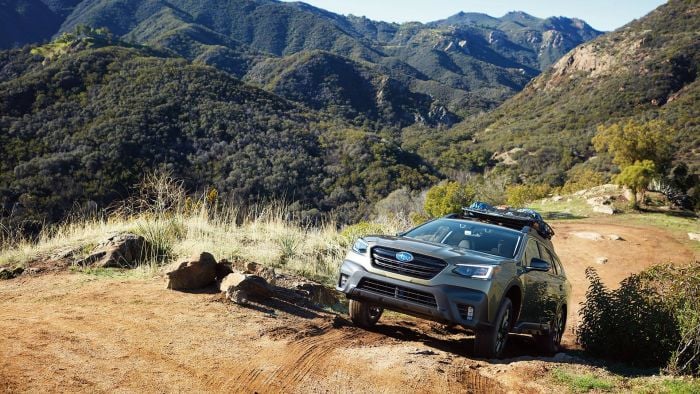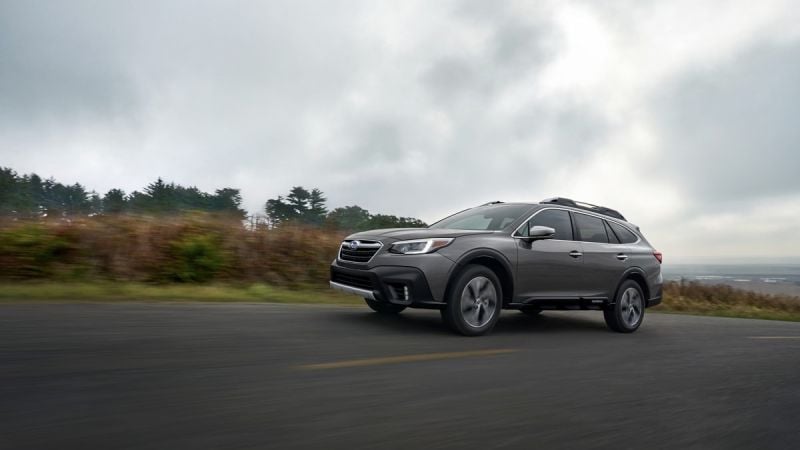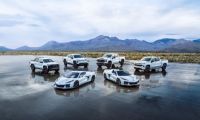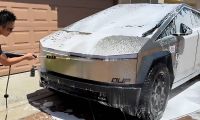When Subaru announced the six-cylinder 3.6-liter Boxer in the Outback was going away, many fans were disappointed. But turbo power is back for the SUV. Powering the 2020 Outback is a newly-available turbocharged 2.4-liter Boxer. It’s sourced from the Ascent family hauler.
The all-new 2020 Outback 2.4 XT comes in Onyx Edition XT, Limited XT, and Touring XT models and they are powered by the brand’s all-new direct-injected turbocharged 2.4-liter Boxer 4-cylinder that beats the current Outback 3.6R engine’s power specs. The 3.6R develops 256 horsepower and 247 lb. ft of torque. The new XT turbocharged 2.4-liter Boxer produces 260 horsepower and 277 lb.-ft. of torque.
More power at lower RPMs
Subaru says the outgoing six-cylinder 3.6R Boxer powerplant sustains just 225 lb-ft of torque from 2,000-6,000 rpm. The new XT turbocharged Outback models benefit from a less broad torque curve, with its 277 lb-ft. of torque achieved from 2,000 rpm through 4,800 rpm. The new Outback XT’s available torque should make a big difference for those pulling a high mountain pass loaded with cargo and people, when pulling a trailer, or climbing a steep mountain trail.
What about fuel economy
The 2019 Outback naturally aspirated six-cylinder 3.6R engine gets an EPA estimated 20/27 city/highway mpg and 22 combined mpg. The new 2020 Outback FA24 2.4-liter engine manufacturer’s estimated fuel economy is 23/30 mpg city/highway with the turbo. Recent reports say the bigger Ascent with the same FA24 2.4-liter turbo isn’t quite getting its 21/27 city highway estimated mpg in the real world.
Why did Subaru ditch the 6-cylinder?
The 3.6R’s demise is no surprise because Subaru Corporation spelled it out in their “Prominence 2020" plan. The plan outlines every Subaru boxer engine will come with the latest Direct Injection technology. Iy also said customers would see smaller turbo engines developing more power and with greater fuel efficiency in the new-generation Subaru vehicles. So far they have produced that in the new Legacy and now Outback.

Pulling power
When equipped with the turbocharged engine, the next-generation Outback is capable of towing 3,500 lbs. up from the 3.6R’s 2700 lb rating. This is a considerable jump due to all that extra available torque. More pulling power will be available from the 2.4-liter turbo with its peak torque at low rpms. If you are pulling a steep trail the 2.4XT will have plenty of low-rpm grunt to get the job done.
If there is a weak link in the Outback power train it’s the Lineartronic CVT automatic transmission. Subaru has made a commitment to the transmission for its fuel-saving characteristics. On the upside, it does feature an 8-speed manual mode function with steering wheel paddle shifters. Subaru keeps improving their CVT, so we’ll see how it performs with the new turbo engine.
2.5-liter is improved
For those who don’t need more power, Subaru still offers the 2.5-liter normally aspirated Boxer engine in the new Outback. It now features nearly 90 percent new parts, as well as direct injection and auto stop/start, and increased output and fuel efficiency. The new engine produces 182 horsepower and 176 lb.-ft. of torque compared with the outgoing model with 175-hp and 174 lb-ft. of torque. Manufacturer’s estimated fuel economy is 26/33 mpg city/highway for the 2.5-liter.
You May Also Like: How New Subaru 2.4L Turbo Engine Compares To Competition’s V6 Power
Leave your comments below, share the article with friends and tweet it out to your followers!
Follow all Subaru news on Facebook, Twitter and Instagram
Photo credit: Subaru USA













Comments
Subaru is not in the same
Permalink
In reply to The 3.6 flat six mated with by Mark Wynn (not verified)
Subaru is not in the same class as the old Volvo built in Sweden, but Ford sold out to China and now there is a gap for a turbo with towing capacity and no CVT.
I have a 2014 forester XT
Permalink
In reply to The 3.6 flat six mated with by Mark Wynn (not verified)
I have a 2014 forester XT turbo at 158,000 miles with the high-torque CVT and it's doing perfectly fine. it'll go well past 200k bone stock.
(Posting again 5 years later…
Permalink
In reply to Will not purchase any vehicle by Ray Kent (not verified)
(Posting again 5 years later). Well, I was never going to buy a CVT. But I replaced my 2010 Outback 3.6 with the last of that engine end of 2019. I took a gamble on the CVT because that is all there is.
Now, after 5 years of ownership O've had no cause to complain. It is slightly quicker and more economical when touring and that's mostly what we have it for - not as a town runabout.
For fastest response when overtaking I use paddle shift and O think many people ignore the fact that this is a car we get more from if we pay attention to how to drive it.
My son now has a new XT 2.4. About to do his first trip then we'll compare notes
"When Subaru announced the
Permalink
"When Subaru announced the six-cylinder flat four 3.6-liter Boxer..." Its is a flat six, not four.
I think they will see there
Permalink
I think they will see there err in there ways in doing this. Chevy put a turbo 4 in their full-size truck boasting the same claims of more hp and tq with better fuel economy. Well they found out a turbo engine actually sucks down more fuel because you are always in the boost trying to make that hp. They along with most people who actually understand the dynamics of how n/a vs forced induction engines work will realize there is no replacement for displacement.
You are forgetting that while
Permalink
In reply to I think they will see there by Aaron M Collins (not verified)
You are forgetting that while high displacement engines can put out consistent horsepower, at cruise (which is what engines spend most of their time doing) the smaller turbo will get better economy during that time. Anticipation of needing more power is feasible in most cases. It's a trip not a drag race.
Why not add a Turbo to the 3
Permalink
In reply to You are forgetting that while by Daniel (not verified)
Why not add a Turbo to the 3.6 Boxer? Does the engine have inherent vulnerabilities caused by higher RPM's & Compression? I'm not complaining - just curious. I know many 3.6's with over 250K miles. At end of day, why dump something that works? 2 MPG's doesn't motivate me or anyone else I know.
Huh that’s weird my name is
Permalink
In reply to I think they will see there by Aaron M Collins (not verified)
Huh that’s weird my name is also Aaron Collins but my middle name isn’t M
Don’t get tired of investing
Permalink
In reply to Huh that’s weird my name is by Aaron (not verified)
Don’t get tired of investing in BTC because of the recent price fluctuations, I know they can sometimes be frustrating but you just have to endure it. Seeing that the crypto space has been getting newcomers and most of them who are without proper understanding usually tend to lose a lot of money as a result of ignorance. Do not trade all by yourself instead, trade under the guidance and supervision of an expert. James Logan an expert from the UK has been the one helping me to trade. His unique strategy and signals are superb, in a space of three months I’ve already been able to accumulate up to 8 BTC. James Logan trade patterns are the best and I think everyone in the trading space should benefit from him. He has a website call; Supreme trade. and you can whatsApp him +44 7418 320073 or Email him [email protected] I am spreading this for those who have issues in turning in consistent profit in the crypto space . Give it a try and you’ll be glad you did.
Here's my take familiar with
Permalink
Here's my take familiar with turbos and the H6. I am a big fan of the H6 and cry much wish Subaru would make a H8 for their larger vehicles. Yes, turbo can be torquey. I have an EJ25 running E85, high boost and makes the same wtq as the bigger 6.4L in the Challenger. There's several problems though. To make power, you're stuck working the small engine harder more of the time. The H6 is a very mild engine, runs on 87, mundane compression, and mid-range tuned. It's an engine that'll run several thousand miles. For comparison, Nissan makes 100hp more with their VQ engine in the 370Z Nismo. The H6 has always been a slow engine because it's so mildly geared. There's a ton of hp left on the table that could have made these cars so much faster. You'll never match the peak torque of turbo setups, but the torque available is instant right off idle and more linear, responsive, and predictable throughout. The larger naturally aspirated engine is a nicer driving experience. It always was and always will be. I have a H4 turbo that makes about twice my H6, but I prefer the H6 for general driving. It's a better experience.
You run into efficiency problems work turbos too. Turbos are not efficient. You have a low compression na engine when off boost, so you're not as optimized as a true NA engine. Once on boost, you need to run the engine very rich to prevent knock. Again, you're not as efficient an the NA engine. The only way to make it work is to make the engine tiny so you're working it some all the time and try and average around light boost where you can still stick near stoichiometric and be pretty efficient. Now you've got 1L to 1.4L turbos making around 200hp and are run hard almost all the time. The savings comes more from light weight and heavy optimization at highway cruising. But heaven forbid if you are a bit of a lead foot or drive a slightly different speed down the highway because mileage can drop like a rock. Turbo engines are extremely dependent on how you drive. Most people will get worse that rated, possibly considerably. NA engines are far less sensitive. Plus a big engine doesn't mean bad mileage. A big V8 Corvette gets 30mpg. Mpg has a lot more to do with low overall weight and minimizing losses during stop and go through the city and good aerodynamics when slicing though the air down the highway. Most often, the engine under the hood matters much less, unless it's inefficiently using the fuel or is running hot, both problems of turbos.
I'm glad the 2.4L is coming to the Outback. I just wish the H6 stayed too or they think about a bigger H8. However, in the modern world, it's more like H4 turbo plus electric motors, battery packs, regen braking, and all that fun stuff. That's just where the world is going.
Your comment makes a lot more
Permalink
In reply to Here's my take familiar with by Matt (not verified)
Your comment makes a lot more sense than the article itself :)
Excellent take. I will keep…
Permalink
In reply to Here's my take familiar with by Matt (not verified)
Excellent take. I will keep my 2018 Legacy with the boxer 6 cylinder as long as it lasts. I am looking forward to tweaking the suspension a bit when the old parts can come off without guilt. Reasonably worn. I do wonder if one can tweak suspensions anymore with computer safeguards on drifting out of your lane etc. Probably so. I will let a dealer do it to assure it allmeshes. Overall a solidcar.
My 2011 Outback 3.6R shows a
Permalink
My 2011 Outback 3.6R shows a tow capacity of 3,000 lbs. All the documemtation shows this. The smaller 4 cylinder engines of this era aren't really rated for towing, hence the 3.6.
I'll be interested in seeing
Permalink
I'll be interested in seeing the real world city fuel economy numbers, when people start reporting in.
While i would really like an Outback with the stronger engine option, city mpg is important to me as well.
If the real world fuel economy is more or less the same as the 3.6r, I'd sooner be shopping for a pre-owned one and save the difference.
Well said. I was leaning
Permalink
In reply to I'll be interested in seeing by Farmer Fred (not verified)
Well said. I was leaning towards keeping my 2017 3.6l Outback at the end of lease due to the 3.6 being discontinued. Your statement is causing me lean towards keeping my 3.6L.
I made the change from Ford
Permalink
I made the change from Ford Escape for just this reason. I tow an enclosed trailer that totals 3000 pounds when loaded. Subaru had the 4 cylinder limited to 1500 pounds and now claim that the 4 cylinder can tow 3500? I fail to see the joke in this. I am also not sure of the CVT for hauling a trailer.
Greetings to you , my first
Permalink
Greetings to you , my first question is what is your credit score ?
If your credit score is still below 700 what are you waiting for ?
I can help you Quickfix your Credit score and clear any bad Credit History for you in 48 hours.
Contact me now if you are interested to boost your Credit score, because with a good Credit score you can easily get any financial help or even buy a car or house easily anywhere in the STATES.
contact me now :[email protected]
Welcome
It all sounds good on paper
Permalink
It all sounds good on paper but...why don't be just make a turbo 1 cylinder engine and get it all over with? Let's face it, the more pressure you put on a smaller engine, the faster it will break down, leak oil, throw a rod, gasket leaks, so on. This way Subaru can make more money. Studies show that the extra cylinder not only give more consistent power, but the extra 2 cylinders balance the engine too. You can't tell me that a perfect running boxer 6 vs a perfect running turbo 4 will last the same before a breakdown. The "better" performance will not last because it is just to little engine for the weight of these vehicles. Very bad move by Subaru.
Spot-n. The 3.5 six and CVT
Permalink
In reply to It all sounds good on paper by Bryan Pinner (not verified)
Spot-n. The 3.5 six and CVT transmission in our 2018 Outback Touring is ultra smooth and neck-snapping powerful. I had driven an Outback four at the dealer, and am ever thankful I opted for the six.Makes the Touring a true luxury wagon.
I had a Vovo turbo-wagon stick-shift in the past that turned into a rocket when the turbo kicked-in ... but Vovo fours were famously over-built and indestructible, lasted hundreds of thousands of miles (the engine, not the turbo) and are still in high demand used, in inboard boats, etc.
You state the out going 3.6
Permalink
You state the out going 3.6 Outback is rated to tow 2,700 lbs. It is rated for 3,000 lbs and the standard 2.5 is rated for 2,700 lbs.
These are great comments but
Permalink
These are great comments but no one mentioned the direct fuel injection. How long before the valves carbon up because of direct injection bypassing the valves and the cost of getting them cleaned.
Wow! I can't believe all the
Permalink
Wow! I can't believe all the negative comments regarding turbocharged engines and direct injection. Look around fellows - we are out of the 1980's. The NA engine is DEAD except for perhaps weed wackers and lawnmowers. Or perhaps we should go back to the old gas sucking, polluting huge displacement engines and 4 barrel carbs? Technology moves on. Absolutely no comparison between the engines of old and the newer technologies. And I am being generous in saying "newer". These technologies have been around for at least a couple of decades, proven successful across the board with all major car manufacturers and provide better performance, fuel economy and cleaner emissions.
Do they require better manufacturing? Of course they do. Anyone could slap together a low revving NA V8. It takes careful engineering and quality manufacture to make a sophisticated small displacement, direct injection turbo charged engine.
We have a 2020 Subaru Outback
Permalink
We have a 2020 Subaru Outback XT Onyx edition in the pearl white. And we love the new turbo engine. We test drove Both the 2.5 premiem and the 2.4 XT Onyx edition. The 2.5 it was all ready it just felt a little under power for us. Plus we live in South Carolina and our neighborhood is on the high hills. So that is why we ended up getting the turbo model. Because the power of the turbo engine really helps us a lot. It really gets up the hills and our long driveway very well. So I say you should test the 2020 Subaru Outback with both engines. Once you test drive the turbo engine you will really love it.
One major thing the flat 6
Permalink
One major thing the flat 6 had over the flat four is greatly decreased NVH. The flat 6's basic design allowed was perfectly balanced in terms of NVH. The flat 4's basic design is perfectly UNBALANCED and experiences much greater NVH that is much more difficult to mitigate. We own a 2019 3.6R Outback Touring and we love it. We have seen as high as 32mpg on highway trips and the engine is smooth as silk. We did test drive an Ascent and while it had good power the turbo flat 4 in that didn't feel as smooth as the flat 6. I also added a Nameless axle-back exhaust and at about 4k and above she sounds like a Porsche flat 6. Ask any Subaru tech which engine is better, the flat 4 or the flat 6, and they'll likely tell you the 6 is better.
Dear Marty,
Permalink
In reply to One major thing the flat 6 by Marty (not verified)
Dear Marty,
I have a 13 OB Limited with 217k and are looking at an 18 3.6R Touring with less than 15k or a 22 XT Limited. What are your overall thoughts? Also, no towing but a lot of highway miles.
Thanks very much.
I just bought my wife a 2020
Permalink
I just bought my wife a 2020 Subaru Outback Limited XT. .As stated in the Owner's manual Use 87 Octane (Minimum) OR higher fuel . I have owned a few German turbos in the past that required Premium 93 so I researched this before buying . Traded in a 2018 Outback Limited 2.5L for the 2020 Limited XT and the performance difference is very noticeable. the 2.4L is a great motor.
Can someone pleeeeaaasee do a
Permalink
Can someone pleeeeaaasee do a review on how the XT performs while towing? Specifically it's average MPG. I cant find a like this review anywhere. I am trying to tow a 14ft vintage trailer, it doesn't weight much, likely less than 2000 lbs. I do not trust my 2017 to be able to tow it with a max capacity of only 2500. We've been towing it with our Tundra, but its way overkill and the gas mileage is killer. I can't find any reviews online about the towing MPG of the XT. Any help appreciated!
This is from Motor Trend,
Permalink
This is from Motor Trend, their testers trashed the XT:
Those who want to see what the 260-hp XT engine has to offer will need to stick with the Onyx XT, Limited XT, and Touring XT trims. Although we found the Onyx fun to slide around off-road, the 2.4 powertrain proved underwhelming on the road. To 60 mph, the engine impresses, with a 6.1-second time that easily improves on the 2018 Outback 3.6R's 6.9 seconds. That's not the full story, though. On the road, we called the engine "unrefined," and the power delivery proved uneven. For a few MotorTrend editors, the engine-transmission interaction is rough enough that we'd select the 2.5-liter engine to avoid it.
From Motor Trend: Those who
Permalink
From Motor Trend: Those who want to see what the 260-hp XT engine has to offer will need to stick with the Onyx XT, Limited XT, and Touring XT trims. Although we found the Onyx fun to slide around off-road, the 2.4 powertrain proved underwhelming on the road. To 60 mph, the engine impresses, with a 6.1-second time that easily improves on the 2018 Outback 3.6R's 6.9 seconds. That's not the full story, though. On the road, we called the engine "unrefined," and the power delivery proved uneven. For a few MotorTrend editors, the engine-transmission interaction is rough enough that we'd select the 2.5-liter engine to avoid it.
Here's what you are
Permalink
Here's what you are forgetting. The 3.6 is smooth, powerful, less time between plug firings, is proven over many years and no timing belt to change. On the other hand, you have a 2.4 that has historic valve cover leaks, revs really high, is noisy, has turbo heat problems, and requires a timing belt change. I'll stick with the 3.6 Boxer thank you. I'm getting 27mpg overall, if you don't believe me I'll send you a picture of my Eco Monitor. You've been outbacked.
Pagination